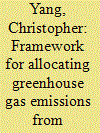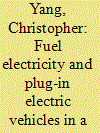|
|
|
Sort Order |
|
|
|
Items / Page
|
|
|
|
|
|
|
| Srl | Item |
| 1 |
ID:
137697


|
|
|
|
|
| Summary/Abstract |
The CA-TIMES optimization model of the California Energy System (v1.5) is used to understand how California can meet the 2050 targets for greenhouse gas (GHG) emissions (80% below 1990 levels). This model represents energy supply and demand sectors in California and simulates the technology and resource requirements needed to meet projected energy service demands. The model includes assumptions on policy constraints, as well as technology and resource costs and availability. Multiple scenarios are developed to analyze the changes and investments in low-carbon electricity generation, alternative fuels and advanced vehicles in transportation, resource utilization, and efficiency improvements across many sectors. Results show that major energy transformations are needed but that achieving the 80% reduction goal for California is possible at reasonable average carbon reduction cost ($9 to $124/tonne CO2e at 4% discount rate) relative to a baseline scenario. Availability of low-carbon resources such as nuclear power, carbon capture and sequestration (CCS), biofuels, wind and solar generation, and demand reduction all serve to lower the mitigation costs, but CCS is a key technology for achieving the lowest mitigation costs.
|
|
|
|
|
|
|
|
|
|
|
|
|
|
|
|
| 2 |
ID:
092839


|
|
|
|
|
| Publication |
2009.
|
| Summary/Abstract |
This paper investigates the potential for making deep cuts in US transportation greenhouse gas (GHG) emissions in the long-term (50-80% below 1990 levels by 2050). Scenarios are used to envision how such a significant decarbonization might be achieved through the application of advanced vehicle technologies and fuels, and various options for behavioral change. A Kaya framework that decomposes GHG emissions into the product of four major drivers is used to analyze emissions and mitigation options. In contrast to most previous studies, a relatively simple, easily adaptable modeling methodology is used which can incorporate insights from other modeling studies and organize them in a way that is easy for policymakers to understand. Also, a wider range of transportation subsectors is considered here-light- and heavy-duty vehicles, aviation, rail, marine, agriculture, off-road, and construction. This analysis investigates scenarios with multiple options (increased efficiency, lower-carbon fuels, and travel demand management) across the various subsectors and confirms the notion that there are no "silver bullet" strategies for making deep cuts in transport GHGs. If substantial emission reductions are to be made, considerable action is needed on all fronts, and no subsectors can be ignored. Light-duty vehicles offer the greatest potential for emission reductions; however, while deep reductions in other subsectors are also possible, there are more limitations in the types of fuels and propulsion systems that can be used. In all cases travel demand management strategies are critical; deep emission cuts will not likely be possible without slowing growth in travel demand across all modes. Even though these scenarios represent only a small subset of the potential futures in which deep reductions might be achieved, they provide a sense of the magnitude of changes required in our transportation system and the need for early and aggressive action if long-term targets are to be met.
|
|
|
|
|
|
|
|
|
|
|
|
|
|
|
|
| 3 |
ID:
124624


|
|
|
|
|
| Publication |
2013.
|
| Summary/Abstract |
This paper describes a number of different allocation methods for assigning greenhouse gas emissions from electricity generation to charging plug-in electric vehicles. These methods for calculating the carbon intensity of electricity are discussed in terms of merits and drawbacks and are placed into a framework to aid in understanding the relation with other allocation methods. Three independent decisions are used to define these methods (average vs. marginal, aggregate vs. temporally-explicit, and retrospective vs. prospective). This framework is important because the use of different methods can lead to very different carbon intensities and studies or analyses that do not properly identify the methods used can confuse policymakers and stakeholders, especially when compared to other studies using different methods.
|
|
|
|
|
|
|
|
|
|
|
|
|
|
|
|
| 4 |
ID:
121265


|
|
|
|
|
| Publication |
2013.
|
| Summary/Abstract |
Electricity is unique among the alternative fuels in a low carbon fuel standard (LCFS) policy, in that demand from vehicles is the major barrier to its usage, not supply. This paper presents a policy discussion and policy recommendations on a number of topics related to the regulation and incentives for fuel electricity within the LCFS. In the near-term, the LCFS will have a limited role in incentivizing the use of electricity and lowering the carbon intensity of electricity, and electricity will play a small role in meeting LCFS targets. Calculating a carbon intensity value for electricity is a complex process, requiring many decisions and trade-offs to be made, including allocation methods, system boundaries, temporal resolution and how to treat electricity demand for vehicle charging. These choices along with other regulatory decisions about who can obtain LCFS credits will influence the incentives for providing electricity and charging infrastructure relative to other low-carbon fuels as well as across different electricity providers. The paper discusses how fuel electricity would fit into an LCFS, identifying those special characteristics that could reduce the effectiveness of the policy. It also provides specific recommendations to enable better policy design that appropriately incentivizes the use of low-carbon fuels.
|
|
|
|
|
|
|
|
|
|
|
|
|
|
|
|
| 5 |
ID:
112290


|
|
|
|
|
| Publication |
2012.
|
| Summary/Abstract |
California's target for reducing economy-wide greenhouse gas (GHG) emissions is 80% below 1990 levels by 2050. We develop transition scenarios for meeting this goal in California's transportation sector, with focus on light-duty vehicles (LDVs). We explore four questions: (1) what options are available to reduce transportation sector GHG emissions 80% below 1990 levels by 2050; (2) how rapidly would transitions in LDV markets, fuels, and travel behaviors need to occur over the next 40 years; (3) how do intermediate policy goals relate to different transition pathways; (4) how would rates of technological change and market adoption between 2010 and 2050 impact cumulative GHG emissions?
We develop four LDV transition scenarios to meet the 80in50 target through a combination of travel demand reduction, fuel economy improvements, and low-carbon fuel supply, subject to restrictions on trajectories of technological change, potential market adoption of new vehicles and fuels, and resource availability.
These scenarios exhibit several common themes: electrification of LDVs, rapid improvements in vehicle efficiency, and future fuels with less than half the carbon intensity of current gasoline and diesel. Availability of low-carbon biofuels and the level of travel demand reduction are "swing factors" that influence the degree of LDV electrification required.
|
|
|
|
|
|
|
|
|
|
|
|
|
|
|
|
| 6 |
ID:
103461


|
|
|
|
|
| Publication |
2011.
|
| Summary/Abstract |
This paper explores how Plug-in Hybrid Vehicles (PHEVs) may reduce source-to-wheel Greenhouse Gas (GHG) emissions from passenger vehicles. The two primary advances are the incorporation of (1) explicit measures of consumer interest in and potential use of different types of PHEVs and (2) a model of the California electricity grid capable of differentiating hourly and seasonal GHG emissions by generation source. We construct PHEV emissions scenarios to address inherent relationships between vehicle design, driving and recharging behaviors, seasonal and time-of-day variation in GHG-intensity of electricity, and total GHG emissions. A sample of 877 California new vehicle buyers provide data on driving, time of day recharge access, and PHEV design interests. The elicited data differ substantially from the assumptions used in previous analyses. We construct electricity demand profiles scaled to one million PHEVs and input them into an hourly California electricity supply model to simulate GHG emissions. Compared to conventional vehicles, consumer-designed PHEVs cut marginal (incremental) GHG emissions by more than one-third in current California energy scenarios and by one-quarter in future energy scenarios-reductions similar to those simulated for all-electric PHEV designs. Across the emissions scenarios, long-term GHG reductions depends on reducing the carbon intensity of the grid.
|
|
|
|
|
|
|
|
|
|
|
|
|
|
|
|
|
|
|
|
|